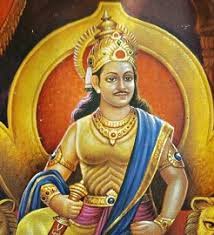
The Golden Era of Chandragupta Vikramaditya
Chandragupta Vikramaditya was not only an emperor, but also a patron of the arts and the sciences, who laid the foundation of India’s Golden Age, with advances in mathematics, literature, and architecture. His most famous work remains to be Vikramankadeepa or The Ocean of Victory – an epic about his own life in verse that illustrates his character and his achievements. Here are 5 things you may not know about Chandragupta Vikramaditya.
Ancient Indian History
The golden era of India’s first emperor, Chandragupta Vikramaditya (375-413 CE) occurred in a time when India was not just ruled by one emperor, but was experiencing a tremendous cultural and political shift. After several attacks from neighboring territories, King Chandragupta II (400-415 CE) decided it was time to expand his empire. From 401 to 405 CE, King Chandragupta II conquered much of northern India. Many Indian rulers did not welcome his power grab; however in 405 CE he managed to capture Pataliputra and become king over a huge area that extended from Afghanistan to Bengal.
Ancient Indian Figures
One of India’s most iconic historical figures was King Chandragupta Vikramaditya, who ruled between AD 375 and 413. He ascended to power after defeating Alexander’s generals in what is now Afghanistan, bringing together a collection of warring kingdoms under his rule. His kingdom reached from Afghanistan to Bangladesh—and included large portions of modern-day Pakistan and parts of Iran and Kashmir—and he oversaw a period of unprecedented peace and prosperity for his subjects. At its peak, his empire stretched all across what was once known as India; today it is recognized as an area encompassing much more than just modern-day India but also Bangladesh, Pakistan, Nepal, Sri Lanka and Bhutan.

Chandragupta Vikramaditya
The 'Golden-Haired' Warrior was a ruler of 3rd century BCE India. A contemporary of Alexander's invasion, he ruled an empire extending from Punjab to central India. He is known as one of greatest rulers in India's history and his kingdom's capital city Pataliputra was described by Arrian as most prosperous city under sun. With its parks, fountains and enormous palaces made out of marble, Pataliputra rivaled Athens in splendor. His empire boasted thousands of elephants and hundreds war chariots where thousands fought on each side.
Navratnas

A term for nine jewels, who were also important advisors to Vikramaditya. This group included Kalidasa, Chanakya, Vishnu Sharma and others. Their brilliance and genius was best exemplified by Kalidasa's dramatic presentation of Vikramadityas's rise to power in his three great plays: Shakuntala, Abhijñānaśākuntalam (The Recognition of Shakuntala) and Malavikagnimitra (Malavika and Agnimitra). In these works he gives a graphic description of all that he saw around him.
Arts & Literature
A warrior poet and an empire builder, Emperor Chandragupta Vikramaditya is rightly celebrated as one of India’s greatest historical figures. Not only did he conquer a vast territory in Northern India, but he also expanded his influence to distant lands. He laid down a code of conduct for his generals and officers, thus establishing a culture that lasted for years after his death. In fact, his impact on Indian culture can still be felt today through various buildings and monuments associated with him. Today we take a look at some lesser-known facts about one of ancient India’s most famous kings. (by bharath_makvana)
conclusion
There are many historical references to king chandragupta11. Ancient texts like mahabharata and rajatarangini mention his greatness as a ruler. However, there has been some confusion as to who he was historically. Many thought that he was just a fictional character used by kings to legitimize their own reigns by associating themselves with a popular ruler from history. Historians have now discounted that notion, realizing that he was in fact real. He ruled over large parts of India and defeated Greek kings in their own lands on several occasions. His main capital, at Ujjain , is now one of the oldest living cities in india and it remains relatively unchanged since his rule more than 2000 years ago.





0 Comments